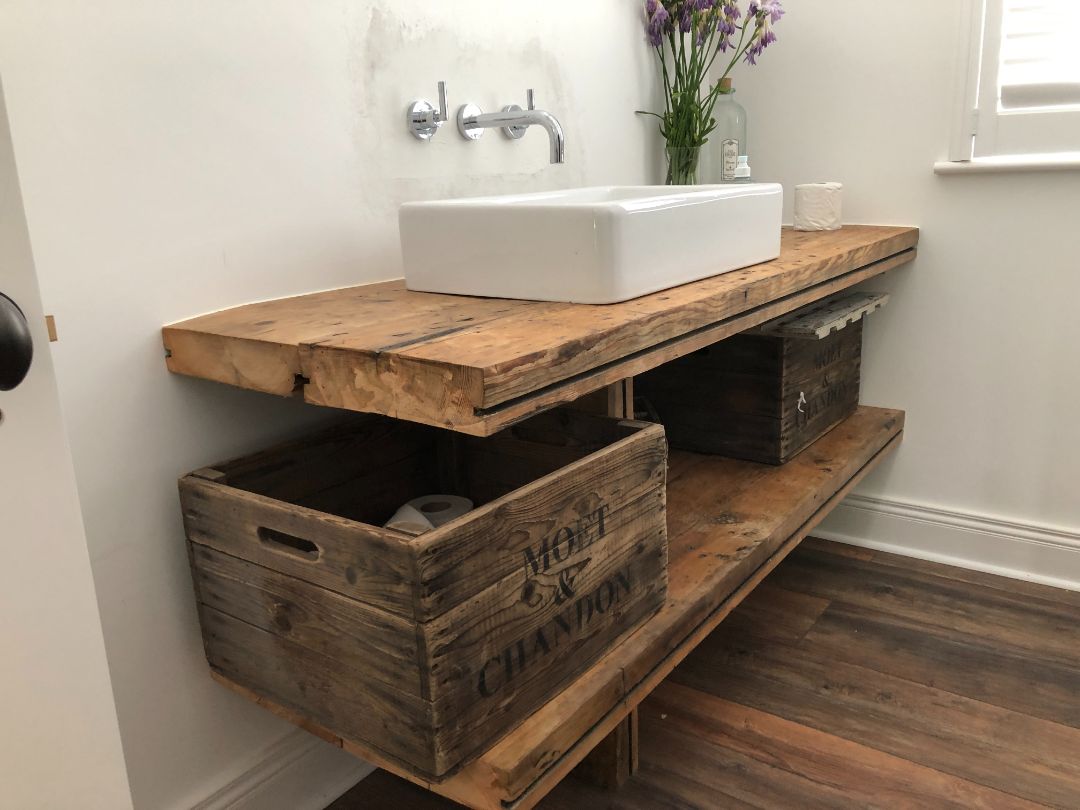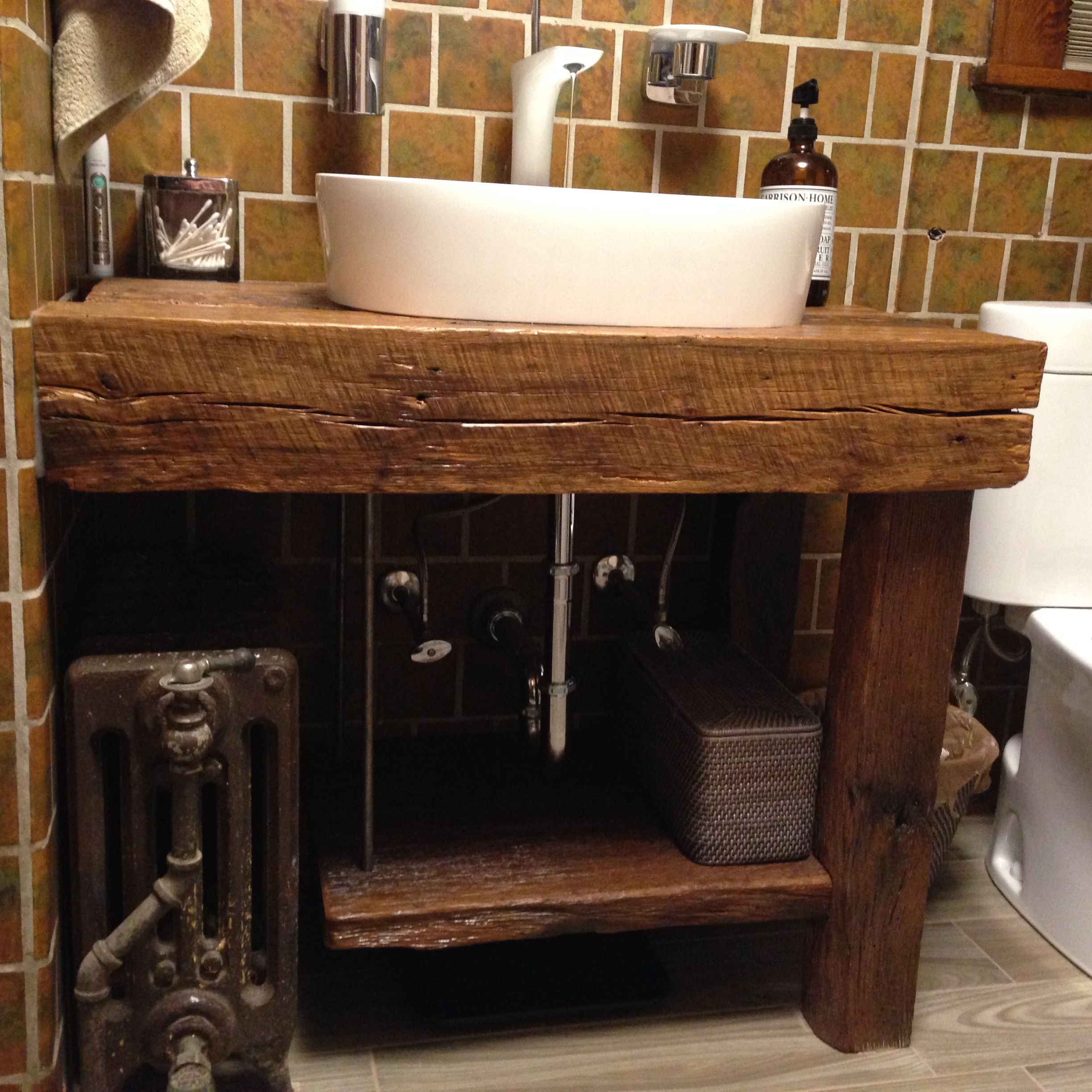The Appeal of Pallet Wood Bathroom Vanities

The use of reclaimed materials in home decor has become increasingly popular, reflecting a growing awareness of sustainability and a desire for unique, character-filled spaces. Pallet wood, in particular, has emerged as a versatile and aesthetically pleasing option, offering a rustic charm and industrial edge that complements various design styles.
Aesthetic Appeal of Pallet Wood Bathroom Vanities
Pallet wood bathroom vanities appeal to those who appreciate the natural beauty of wood and the unique character it brings to a space. The rustic and industrial design styles, often associated with pallet wood, create a warm and inviting atmosphere, contrasting with the typically sleek and modern bathroom designs.
- Rustic Charm: The natural imperfections and variations in color and texture of pallet wood create a warm and inviting ambiance, reminiscent of farmhouse and cottage styles. The rough-hewn edges and knots add a touch of authenticity and character to the vanity, making it a focal point of the bathroom.
- Industrial Edge: The raw and unrefined nature of pallet wood lends itself well to industrial design aesthetics. The use of metal accents, such as pipe legs or hardware, further enhances the industrial feel, creating a modern and edgy contrast with the natural wood.
Uniqueness and Character
Pallet wood vanities offer a unique and personalized touch to bathroom spaces. Each piece of pallet wood has its own history and unique characteristics, resulting in a one-of-a-kind vanity that reflects the individual style and preferences of the homeowner.
- Natural Variations: The natural variations in grain patterns, knots, and color create a unique and visually appealing texture that sets pallet wood vanities apart from traditional bathroom furniture.
- Customization: Pallet wood is a highly customizable material. Homeowners can choose to stain or paint the wood to match their desired aesthetic, adding a personal touch to the vanity.
Environmental Benefits
Using repurposed pallet wood for bathroom vanities is an environmentally conscious choice that promotes sustainability. By giving new life to discarded materials, homeowners contribute to reducing waste and minimizing the environmental impact of furniture production.
- Reduced Waste: Pallet wood is often discarded as waste, contributing to landfill accumulation. Repurposing pallet wood for bathroom vanities helps to reduce waste and promote a circular economy.
- Sustainable Choice: Using reclaimed materials like pallet wood is a sustainable alternative to sourcing new wood, which often involves deforestation and other environmental impacts.
Designing and Building a Pallet Wood Vanity

Creating a pallet wood bathroom vanity is a rewarding project that allows you to express your creativity while adding a rustic charm to your bathroom. Transforming reclaimed pallet wood into a functional and stylish vanity involves careful planning, precise measurements, and the right tools and materials.
Materials and Tools
A successful pallet wood vanity project requires a thoughtful selection of materials and tools.
- Pallet Wood: Choose sturdy and untreated pallet wood. Inspect for any damage or rot.
- Wood Glue: Use a strong wood glue specifically designed for woodworking projects.
- Wood Screws: Select screws that are long enough to securely fasten the pallet wood components.
- Wood Filler: Use wood filler to cover any gaps or imperfections in the pallet wood.
- Sandpaper: Use various grits of sandpaper to smooth the pallet wood surfaces and prepare them for finishing.
- Paint or Stain: Choose a suitable paint or stain that complements your bathroom decor. Water-based finishes are generally preferred for bathroom environments.
- Polyurethane Finish: Apply a polyurethane finish to protect the vanity from moisture and spills.
- Measuring Tape: Accurately measure the dimensions of the vanity and its components.
- Circular Saw or Hand Saw: Cut the pallet wood to the desired sizes.
- Drill: Drill pilot holes before screwing the pallet wood components together.
- Screwdriver: Securely fasten the pallet wood components with screws.
- Clamps: Hold the pallet wood pieces together while the glue dries.
- Level: Ensure the vanity base is level and stable.
- Safety Glasses and Gloves: Protect your eyes and hands during the project.
Measuring and Cutting Pallet Wood
Accurate measurements are crucial for a well-proportioned and functional vanity.
- Determine Vanity Size: Measure the available space in your bathroom and decide on the desired dimensions of the vanity.
- Plan the Layout: Sketch a simple plan of the vanity, including the location of shelves, drawers, and the sink.
- Cut Pallet Wood Components: Using a circular saw or a hand saw, carefully cut the pallet wood to the required lengths and widths. Ensure the cuts are precise and straight.
- Sanding: Smooth the edges and surfaces of the cut pallet wood pieces with sandpaper to remove any splinters or rough spots.
Building a Sturdy Base, Pallet wood bathroom vanity
The base of the vanity is the foundation of the entire structure.
- Choose Strong Pallet Wood: Select sturdy and wide pallet wood planks for the base to ensure stability and weight-bearing capacity.
- Assemble the Base: Join the pallet wood planks together using wood glue and screws. Use clamps to hold the pieces together while the glue dries. Ensure the base is square and level.
- Reinforce the Base: Consider adding cross-bracing or support beams to further reinforce the base, especially if the vanity is large or will hold a heavy sink.
Adding Storage Compartments
Storage compartments can add functionality and enhance the usability of the vanity.
- Shelves: Create shelves using pallet wood planks, cut to the desired lengths and widths. Attach them to the base using wood glue and screws.
- Drawers: If you’re comfortable with more advanced woodworking, you can create drawers using pallet wood and drawer slides.
- Open Storage: Consider creating open storage compartments using pallet wood frames or by leaving sections of the base open.
Finishing Touches
After assembling the vanity, you can add finishing touches to enhance its appearance and protect it from moisture.
- Fill Gaps: Use wood filler to cover any gaps or imperfections in the pallet wood.
- Sanding: Smooth the entire vanity surface with sandpaper to achieve a uniform finish.
- Painting or Staining: Apply a paint or stain that complements your bathroom decor. Multiple coats may be necessary for a smooth and even finish.
- Polyurethane Finish: Apply a polyurethane finish to protect the vanity from moisture and spills. Allow the finish to dry completely before using the vanity.
Finishing and Styling a Pallet Wood Vanity: Pallet Wood Bathroom Vanity

The rustic charm of pallet wood can be enhanced with careful finishing and styling. This process involves sanding and smoothing the wood, applying stains, paints, or varnishes, and incorporating hardware and accessories to complement the vanity’s natural aesthetic.
Sanding and Smoothing Pallet Wood
Pallet wood often has rough surfaces, knots, and imperfections. These features contribute to its rustic charm, but they also require proper sanding and smoothing to create a more polished and functional vanity.
- Start with coarse-grit sandpaper (80-120 grit) to remove any large splinters or protruding nails.
- Gradually progress to finer grits (150-220 grit) for a smoother finish.
- Use a sanding block or orbital sander for consistent sanding and to avoid creating uneven surfaces.
- Pay attention to corners and edges, ensuring they are smooth and rounded to prevent injuries.
- For a truly smooth finish, consider using a fine-grit sandpaper (240-400 grit) and a sanding sealer.
Applying Finishes
The choice of finish depends on the desired look and the level of protection required. Stains enhance the wood’s natural grain, paints provide a solid color, and varnishes create a protective layer.
- Stains come in various colors and shades, allowing you to customize the vanity’s appearance.
- Paints offer a wider range of color options and can be used to create a modern or vintage look.
- Varnishes protect the wood from moisture, scratches, and stains, enhancing its durability.
- Apply stains, paints, and varnishes in thin, even coats, allowing each coat to dry completely before applying the next.
- Consider using a brush, roller, or spray gun for application, depending on the desired finish and the size of the vanity.
Incorporating Hardware and Accessories
Hardware and accessories play a crucial role in completing the vanity’s style and functionality.
- Choose hardware that complements the rustic aesthetic, such as antique brass or bronze pulls, knobs, and hinges.
- Consider using salvaged or repurposed hardware to enhance the vanity’s eco-friendly appeal.
- Add decorative elements, such as a mirror with a rustic frame, a woven basket for storage, or a potted plant.
- Integrate lighting fixtures that complement the vanity’s style, such as sconces or pendant lights with a rustic or industrial design.
Integrating a Pallet Wood Vanity into Bathroom Styles
Pallet wood vanities can be seamlessly integrated into various bathroom styles, adding a unique touch to each design.
- Rustic Bathroom: Embrace the natural beauty of the pallet wood by using a clear or natural-toned stain. Add rustic elements, such as a woven rug, a distressed wood mirror, and stone accents.
- Industrial Bathroom: Opt for a dark stain or paint to create a rugged and industrial feel. Incorporate metal accents, exposed pipes, and Edison bulb lighting.
- Modern Bathroom: Use a white or gray paint to create a clean and modern look. Add sleek hardware, geometric mirrors, and contemporary lighting.
- Transitional Bathroom: Combine elements from different styles, such as a distressed wood vanity with modern hardware, a woven basket, and a geometric mirror.
Creating a Cohesive Bathroom Design
A cohesive bathroom design requires careful consideration of color palettes, textures, and accessories.
- Choose a color palette that complements the pallet wood vanity, considering its natural tones and the overall style of the bathroom.
- Incorporate textures that create visual interest, such as woven rugs, ceramic tiles, or natural stone accents.
- Select accessories that enhance the vanity’s style and functionality, such as a soap dispenser, toothbrush holders, and storage baskets.
A pallet wood bathroom vanity can be a beautiful and eco-friendly addition to your space. While you’re focusing on the vanity, don’t forget about the shower curtain! You might find some interesting options when exploring bathroom shower curtains in Sri Lanka , which can add a unique touch to your bathroom.
Once you’ve decided on your shower curtain, you can continue focusing on your pallet wood vanity, ensuring it complements your overall bathroom design.
A pallet wood bathroom vanity can bring a rustic charm to your bathroom, especially when paired with other natural elements. Imagine stepping into your sanctuary, where a pallet wood vanity complements a luxurious bathroom with garden tub and shower , creating a space that feels both grounded and elegant.
The warmth of the wood and the inviting ambiance of a garden tub and shower can create a sense of tranquility and rejuvenation, making your bathroom a true oasis for self-care.